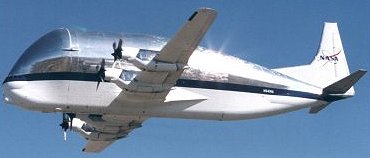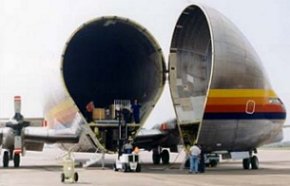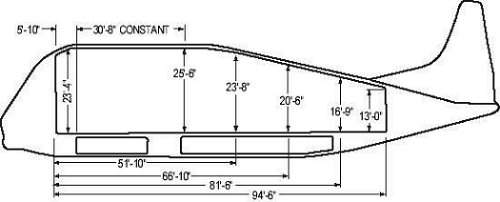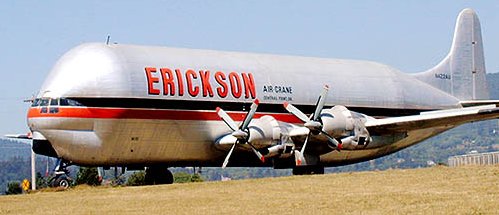Super Guppy
Today, an implausible airplane. The University of Houston's College of Engineering presents this series about the machines that make our civilization run, and the people whose ingenuity created them.
You've seen them, I'm sure — in magazines, at air shows, or maybe off in a distant corner of some airport. They are the strangest flying machines. They'd pass for four-engine propeller-driven airliners from the 1950s, except for the fuselage — the body swollen up to gigantic proportions. You'd think there'd be no way these great, inflated monsters could ever get off the ground.
 This airplane, called a Super Guppy, has a shape that seems to violate every rule of sensible design. And yet, it is an important link in America's space program. But, let's back up a moment. The antecedent of this weirdly-proportioned beast was the B-29 Stratofortress, which began replacing B-17 bombers in the late days of WW-II. The B-29 was a big airplane with great range and altitude.
This airplane, called a Super Guppy, has a shape that seems to violate every rule of sensible design. And yet, it is an important link in America's space program. But, let's back up a moment. The antecedent of this weirdly-proportioned beast was the B-29 Stratofortress, which began replacing B-17 bombers in the late days of WW-II. The B-29 was a big airplane with great range and altitude.
In a modified cargo version, it became the KC-97, whose body had a figure-eight cross-section. From that emerged the last great propeller-driven airliner, the Boeing Stratocruiser. Only 56 Stratocruisers were built, but they were the most comfortable of the propeller-driven airliners. The passenger seating was in the upper lobe of the figure eight, with a lounge in the lower lobe.
But, by the late 1950s, propeller driven airliners were being put out of business by the new Boeing 707 jets. And that might have been the end of the Stratocruiser. However, NASA faced a serious problem in the late 1950s. The rockets they were launching at Cape Canaveral, in Florida, were being made in California. How to move large rocket parts across the country?
Science writer Robert Trip tells us they wouldn't fit on highways or on railways. And, after a fifteen-day ocean voyage through the Panama Canal, they usually arrived damaged.
 So, some developers gambled on a radical plan. They formed a company and began buying surplus Stratocruisers and KC-97s. They cut a Stratocruiser in half, lengthened the body by sixteen feet, then grossly increased its diameter. They called it the Pregnant Guppy.
So, some developers gambled on a radical plan. They formed a company and began buying surplus Stratocruisers and KC-97s. They cut a Stratocruiser in half, lengthened the body by sixteen feet, then grossly increased its diameter. They called it the Pregnant Guppy.
It was all done in remarkable haste. Trip tells how the de-velopers got away with flying Werner von Braun in a seriously-flawed, not-yet-ready, version of the airplane. The Pregnant Guppy was followed by the Very Pregnant Guppy, later renamed Super Guppy. They also made a smaller version -- the Mini Guppy.
The Super Guppy has a twenty-five-foot diameter empty space into which NASA loaded huge components of Gemini, Apollo, and Skylab. It's done other jobs as well, like moving the fuselage of a Concorde SST. The inside is so large it could house the Olympic pole vault event. And Super Guppies have recently moved sections of the International Space Station.
So, the next time you see one of those superbly weird airplanes, know that they really do fly. And know that function is not always obvious in the machines we build. Sometimes the most unexpected things really do function.
I'm John Lienhard, at the University of Houston, where we're interested in the way inventive minds work.
(Theme music)
R. S. Tripp, Pregnant Guppy: The Strange Epic of the Ugly Airplane that Got Us to the Moon. Invention and Technology, Vol. 17, No. 4, Spring 2002, pp. 30-37.
Except as noted, all images are courtesy of NASA.

Dimensions of the Super Guppy

Mini Guppy, Evergreen Flight Museum
(Photo by John Lienhard)